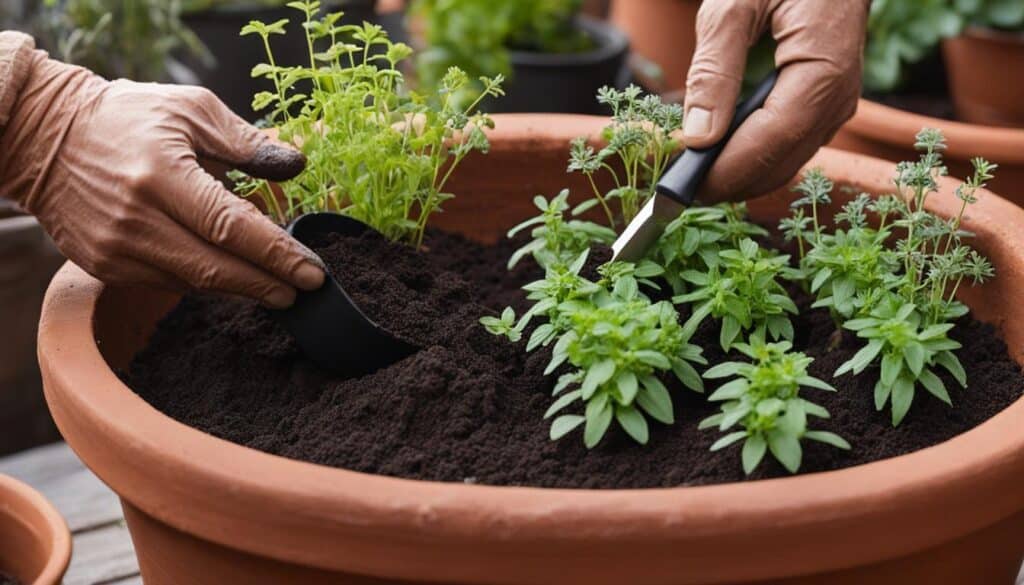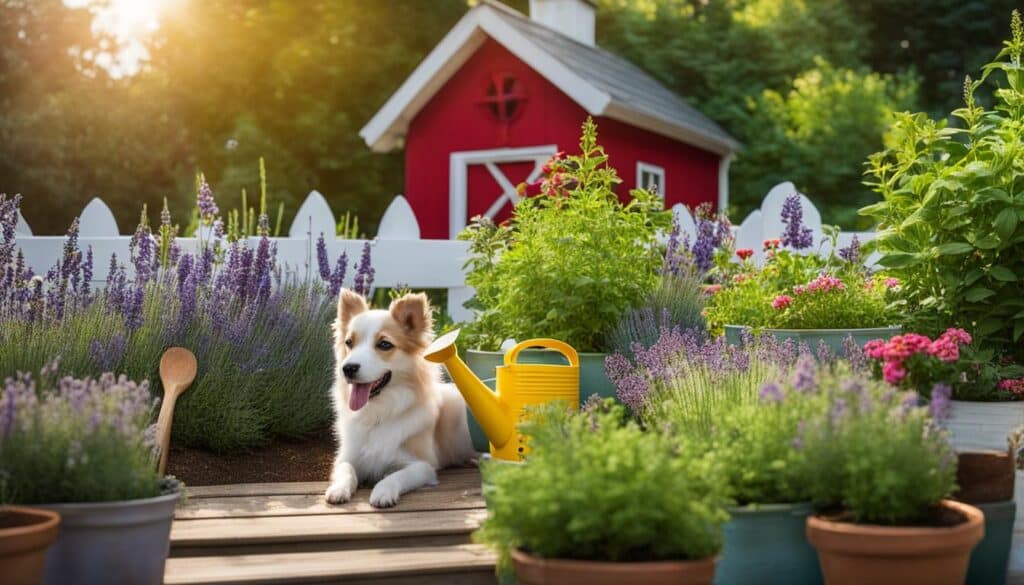Grow a Dog-Friendly Herb Garden: A DIY Guide

Welcome to our DIY guide on how to grow a dog-friendly herb garden! If you are a pet parent who loves gardening and wants to provide your furry friend with safe and healthy plants to enjoy, this article is for you. In this guide, we will explore everything you need to know about creating a dog-friendly herb garden, including choosing pet-safe plants and creating an optimal growing environment. Let’s get started on this pawsome gardening adventure!
The Benefits of a Dog-Friendly Herb Garden
Planting a dog-friendly herb garden offers numerous benefits for both you and your furry companion. Herbs not only provide beauty and life to your landscape but also have various health benefits. They contain essential vitamins and minerals that can support your dog’s immune system, improve digestion, freshen breath, and more. By growing a pet-safe herb garden, you can enhance your pup’s well-being while enjoying the beauty and functionality of these plants.
Herbs in your dog-friendly garden provide a natural and accessible source of nutrients for your four-legged friend. They are packed with vitamins A, C, and K, as well as minerals like calcium, iron, and potassium. These nutrients can help boost your dog’s overall health and vitality, supporting their immune system and promoting optimal bodily functions.
Furthermore, certain herbs have specific health benefits for dogs. For example, parsley is known for its breath-freshening properties, while ginger can help soothe upset stomachs and aid digestion. Rosemary has antioxidant properties that can support brain function, and chamomile can promote relaxation and reduce anxiety in dogs. Incorporating these herbs into your pet’s diet can have a positive impact on their well-being.
The beauty of a dog-friendly herb garden extends beyond its health benefits. These plants add color, texture, and visual interest to your outdoor space, enhancing the overall appearance of your landscape. Whether you choose to grow them in pots, raised beds, or directly in the ground, herbs can create a stunning backdrop for your garden.
“A dog-friendly herb garden not only adds beauty to your surroundings, but it also provides a sensory experience for your furry friend, with various scents and textures to explore.”
In addition to their visual appeal, herbs can serve practical purposes in your garden. Many herbs have natural pest-repellent properties, helping to keep unwanted insects at bay without the need for harmful chemicals. For example, lavender and mint can deter pests like mosquitoes, while marigolds can ward off aphids and other garden pests.
Furthermore, having a dog-friendly herb garden encourages outdoor activity and bonding time with your pet. You can involve your furry friend in the gardening process, allowing them to explore the fragrant foliage and engage their senses. This shared experience creates a stronger connection between you and your dog, promoting a healthy and active lifestyle.
Key Benefits of a Dog-Friendly Herb Garden:
- Provides essential vitamins and minerals for your dog’s health
- Supports the immune system and promotes overall well-being
- Offers specific health benefits, such as freshening breath and aiding digestion
- Enhances the beauty and aesthetics of your landscape
- Adds color, texture, and visual interest to your outdoor space
- Acts as a natural pest repellent
- Encourages outdoor activity and bonding with your furry companion
Choosing the Right Plants
When it comes to creating a dog-friendly herb garden, selecting the right plants is essential. Some plants can be toxic to pets, which is why it’s crucial to choose pet-friendly herbs to ensure the safety and well-being of your furry friend. By referring to resources like the ASPCA’s list of toxic and non-toxic plants, you can confidently make plant selections that are safe for your dog.
Here are some popular pet-safe herbs that you can consider for your dog-friendly herb garden:
| Pet-Friendly Herbs | Notes |
|---|---|
| Parsley | Rich in vitamins and antioxidants |
| Oregano | Contains antibacterial properties |
| Basil | Known for its calming effects |
| Rosemary | Has antioxidant and anti-inflammatory properties |
| Lemon Balm | Helps with relaxation and digestion |
| Sage | Known for its anti-microbial properties |
You can select these herbs based on your dog’s preferences and the herbs you commonly use in your cooking. Not only will they provide a safe and enjoyable environment for your dog, but they will also add flavor to your own dishes when harvested.
Remember, it’s crucial to avoid toxic plants when choosing herbs for your dog-friendly garden. Educate yourself about toxic plants and refer to reliable resources to ensure you make the right plant selections. Your dog’s safety should always be a top priority.
“Having a dog-friendly herb garden is not just about providing a safe environment for your furry friend, but also an opportunity to enrich your cooking and enjoy the benefits that these pet-safe herbs offer.” – Expert Gardener
Planting and Caring for Your Herb Garden
Planting a dog-friendly herb garden is relatively easy, even for beginners. Follow these simple steps to create a thriving herb garden that both you and your furry companion will love.
Choose the Right Pot and Potting Mix
Start by selecting a medium-sized sturdy pot that allows for proper drainage. This will prevent waterlogged roots and ensure the health of your herbs. Fill the pot with a high-quality potting mix, which provides essential nutrients and promotes healthy growth.
Optimize Space with Strategic Planting
When planting your herb garden, consider the space available and arrange your chosen seedlings or seeds strategically. Optimize space by planting taller herbs towards the back and shorter ones towards the front. This will allow for efficient use of sunlight and make it easier to care for your plants.
Find the Best Spot for Sunlight
Place your pot in a sunny spot where your herbs can receive adequate sunlight throughout the day. Most herbs thrive in full sun, so choose a location that offers at least 6-8 hours of direct sunlight. This will ensure optimal growth and flavor development in your herbs.
Watering: The Key to Healthy Herbs
Proper watering is essential for the health of your herb garden. Water your herbs as needed, ensuring that the soil is moist but not waterlogged. Stick your finger into the soil up to the first knuckle, and if it feels dry, it’s time to water. Avoid overwatering, as this can lead to root rot and other issues.
Harvesting for Flavorful Delights
One of the joys of having an herb garden is the ability to harvest fresh herbs for culinary delights. Regularly prune or harvest your herbs to encourage new growth and keep the plants healthy. Use the harvested herbs in your dog’s meals or as flavorful additions to your own dishes, adding a touch of freshness and aroma to every bite.

With these simple steps, you can successfully plant and care for your dog-friendly herb garden. Providing the right potting mix, ensuring proper watering, and harvesting regularly will promote healthy growth and allow you and your furry companion to enjoy the flavors and benefits of your own homegrown herbs.
Tips for a Successful Herb Garden
To ensure your dog-friendly herb garden thrives, follow these tips for success:
Spot Selection
Choose a spot for your garden that receives ample sunlight but is protected from harsh elements. Herbs typically require at least 6 hours of direct sunlight each day to grow and thrive. Consider placing your garden near a sunny window or in an outdoor area with good sun exposure.
Soil Quality
Use a high-quality potting mix that provides proper drainage and nutrients for your herbs. The soil should be well-drained to prevent overwatering and root rot. Look for a potting mix specifically designed for herbs or vegetables, as these blends often contain the necessary nutrients to support healthy plant growth.
Watering
Water your plants as needed, allowing the soil to dry out between watering sessions. Overwatering can lead to root rot and other issues, so it’s important to find the right balance. Check the moisture level of the soil by inserting your finger about an inch deep into the soil. If it feels dry, it’s time to water your herbs.
Fertilizer
Consider using organic fertilizers to provide your herbs with the necessary nutrients. Organic fertilizers are typically pet-safe and help promote healthy growth. Avoid using chemical-based fertilizers that may be harmful to pets if ingested. Follow the manufacturer’s instructions for the appropriate application and frequency of fertilization.
Quote:
“A well-chosen spot, quality soil, proper watering, and pet-safe fertilizers are the key ingredients for a successful dog-friendly herb garden.” – Expert Gardener
By following these tips, you’ll create an environment that is conducive to the growth and well-being of your dog-friendly herb garden. Remember to regularly monitor your plants for any signs of pests or disease and take appropriate action to maintain their health.

| Spot Selection | Soil Quality | Watering | Fertilizer |
|---|---|---|---|
| Choose a spot with ample sunlight and protection from harsh elements. | Use a high-quality potting mix with proper drainage and nutrients. | Water as needed, allowing the soil to dry out between watering sessions. | Consider organic fertilizers for pet-safe nutrition. |
Conclusion
Creating a dog-friendly herb garden is a rewarding project that offers a range of benefits for both you and your furry companion. By following this DIY guide, you can grow a beautiful and pet-safe herb garden that will enhance your home and provide fresh ingredients for your meals.
The health benefits of pet-safe herbs are numerous. Not only do they contain essential vitamins and minerals, but they can also support your dog’s immune system, aid digestion, and freshen breath. Additionally, the joy of harvesting your own herbs adds a sense of accomplishment and satisfaction to your gardening experience.
Whether you are an experienced gardener or a novice, creating a dog-friendly herb garden is within your reach. By selecting pet-safe herbs, providing optimal growing conditions, and following the tips laid out in this guide, you can create a vibrant and safe environment for your pup to explore. So start your journey towards a dog-friendly herb garden, and enjoy the wonders it brings to both you and your furry friend.
FAQ
What are the benefits of creating a dog-friendly herb garden?
Planting a dog-friendly herb garden not only adds beauty to your landscape but also provides health benefits for your furry companion. The herbs contain essential vitamins and minerals that can support your dog’s immune system, improve digestion, freshen breath, and more.
How do I choose the right plants for my dog-friendly herb garden?
It’s crucial to choose pet-friendly herbs for your garden. Avoid plants that can be toxic to pets by referring to resources such as the ASPCA’s list of toxic and non-toxic plants. Some popular pet-safe herbs include parsley, oregano, basil, rosemary, lemon balm, and sage.
How do I plant and care for my dog-friendly herb garden?
Start by selecting a medium-sized sturdy pot and filling it with quality potting mix. Plant your chosen herb seedlings or seeds, arranging them strategically for optimal space usage. Place your pot in a sunny spot with adequate sunlight and water your herbs as needed, being careful not to overwater. Prune or harvest the herbs regularly to encourage growth.
What tips can you provide for a successful dog-friendly herb garden?
To ensure your herb garden thrives, choose a spot with ample sunlight and protection from harsh elements. Use a high-quality potting mix that promotes proper drainage and nutrient absorption. Water your plants as needed, allowing the soil to dry out between watering sessions. Consider using organic fertilizers and pet-safe pesticides to maintain a healthy garden.






